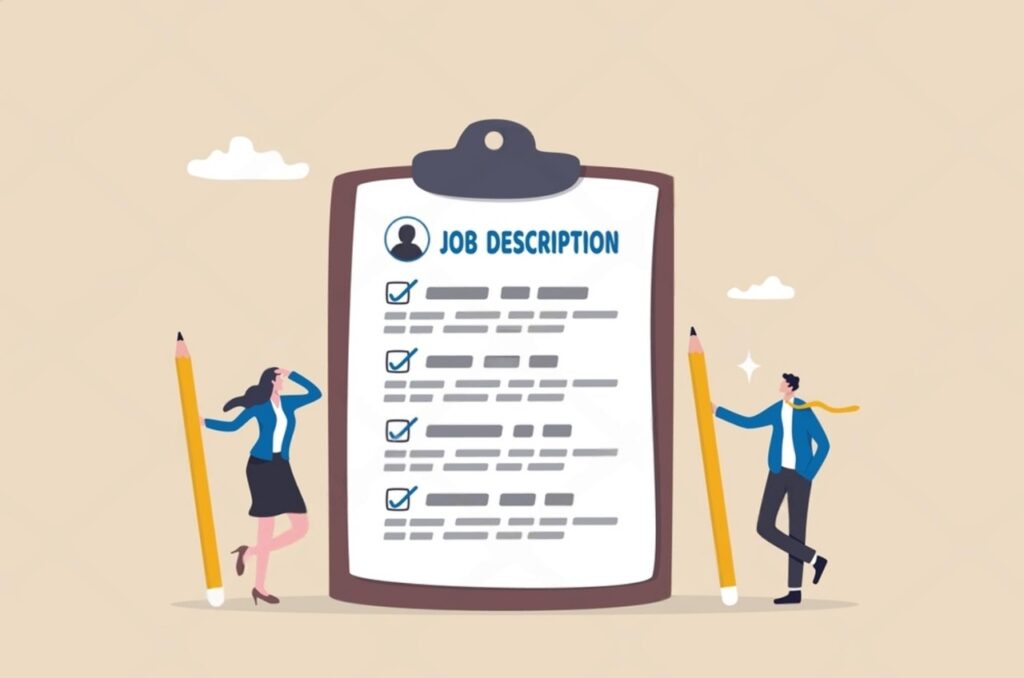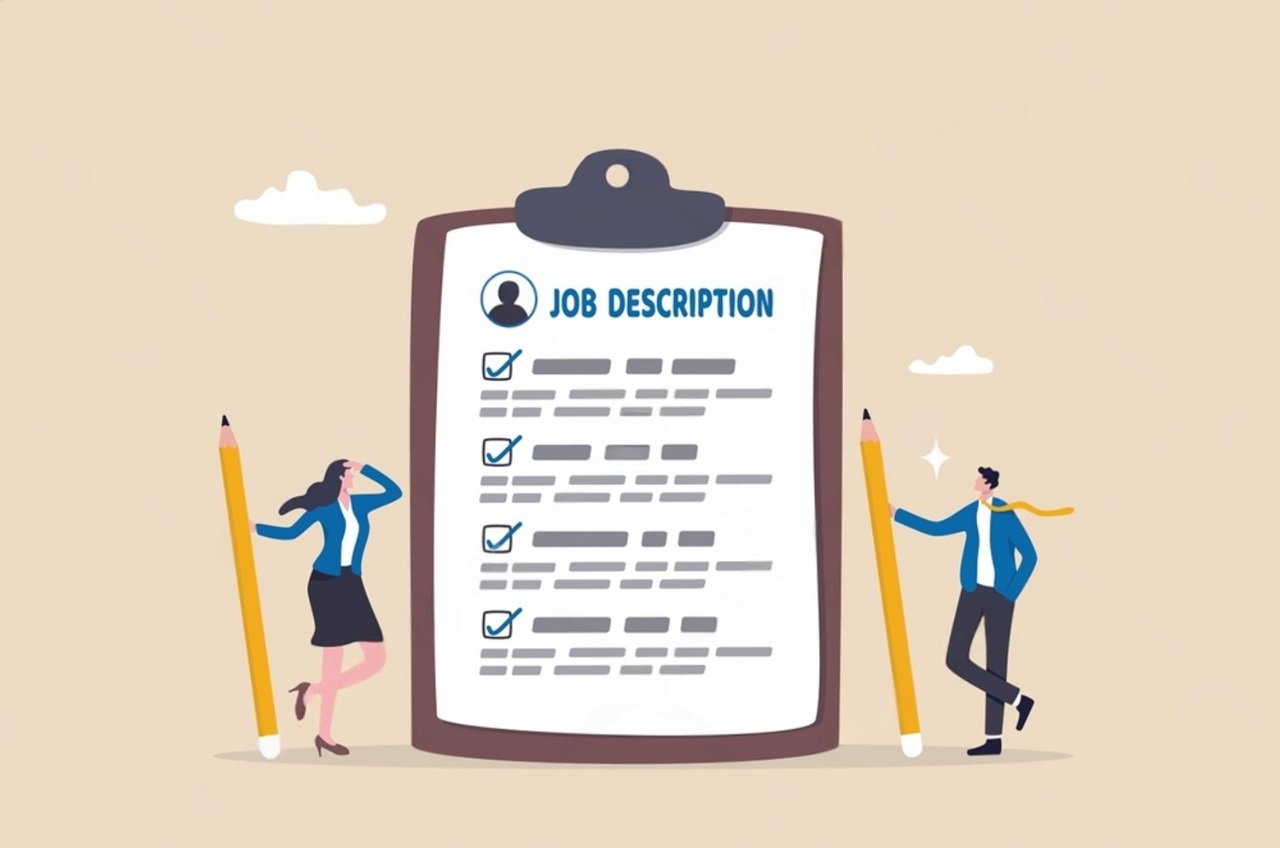A job description is a comprehensive outline of the responsibilities, qualifications, and skills required for a position. It is the foundation of any successful recruitment process. It is a roadmap for employers and candidates alike, helping both parties understand the expectations and requirements of a role.
Whether you’re hiring for a startup or a well-established company, an effective job description can attract the right talent and save time in the hiring process. It also sends the right message to potential employees and shows your investment.
In this article, we’ll guide you through how to write a job description that is clear, concise, and appealing to Indian job seekers.
What is a Job Description?
A job description highlights the role and responsibilities of a work position. A job description is a critical marketing tool to attract qualified candidates and a vital resource for setting clear expectations and guiding the interview process. It is used to announce openings within a company and what kind of candidate is needed to fill the role.
Having an attractive and clear job description makes sure that you find the perfect fit for your company and that the candidates can make an informed decision.
Important Parts of a Job Description
Any effective job description should contain certain elements that highlight the key details of the job. In order to ensure that your company is able to attract the right candidate, the following details should be conveyed clearly:
- Job Title: The name of the position it is mostly widely known as.
- Compensation: The compensation section details what your company is willing to offer for the role. This includes monetary compensation as well as extra benefits.
- Location: The location of the office where the employee is expected to be working from. It also details whether the work is on-site, hybrid, or fully remote.
- Job Summary: This provides a brief idea of the duties and responsibilities of the job role.
- Job Responsibilities: A list of duties that fall under the purview of the job role.
- Job Qualifications: The skill requirements for the job role. This includes minimum requirements and highlights any preferred qualifications.
- Organization Description: Job Descriptions typically include a summary of the company and the kind of environment and perks an employee enjoys as a part of the company.
- How to Apply: This section details how an interested candidate can apply for the mentioned position.
Bear in mind that these sections are the soul of a job description. While you can add your own personal touch by adding more details, the sections mentioned above are what candidates will expect as a bare minimum from your job description.
Importance of Job Descriptions in Recruitment
A well-crafted job description is more than a document; it is a critical tool for connecting employers with potential employees. A job description is a comprehensive outline of the responsibilities, qualifications, and skills required for a position. As such, there are multiple reasons why knowing how to write a job description is essential during the recruitment process:
- It helps candidates self-assess their suitability for the role, ensuring employers attract talent with the right qualifications and skills.
- A job description sets the tone for the employer-employee relationship by outlining the role’s expectations.
- It is also a reference point for performance evaluations, training, and career development.
- In India, where the job market is diverse and competitive, clarity in job descriptions can significantly improve the quality of applications received.
Conducting Job Analysis
Before drafting a job description, take the time to understand the role thoroughly. Perform a detailed job analysis to define the scope of the position. The process involves answering questions like:
- What are the day-to-day responsibilities of the role?
- What qualifications are non-negotiable?
- Which skills will help the candidate excel in this position?
For example, when hiring a Procurement Manager, outline critical tasks such as vendor negotiations, inventory control, and budget management. Specify qualifications like a degree in supply chain management or business administration and highlight skills like analytical thinking, communication, and proficiency in relevant software.
Having a thorough understanding of what the role requires is a key step in writing effective job descriptions. It also helps smoothen the hiring process by providing your company with the key qualities to look for in a candidate.
Structuring a Job Description

An effective job description should have a logical structure. It should be easy to follow and use terms that are relevant to those that the job description is aiming to attract.
Most job descriptions follow a template similar to the one below:
Job Title
Start with a clear and precise job title that reflects the role. Stick to widely recognized titles like Content Writer, Sales Executive, or IT Manager. Avoid creative titles like “Office Ninja” or “Marketing Guru,” as these can confuse candidates.
Compensation
Be clear about what you are willing to offer to the selected candidate. Compensation includes monetary salary as well as perks like health insurance. These benefits play a huge role in generating interest for you position in a candidate’s mind.
You can also share details regarding your leave policy in this section as paid leaves are considered part of the total compensation. Make sure that the compensation that you are offering is competitive with the offerings from other organizations.
Location
Share the city where your office is located. This is immensely important if you want the future employee to come to the office and work on-site.
With the rise in the remote work culture, be clear about your expectations regarding office presence. Clearly state whether your company is working on-site, from home, or follows a hybrid work model.
Job Summary
Provide a brief overview of the role. This section should highlight the position’s purpose and importance within the organization. Keep it concise, ideally within 2-3 sentences.
Example:
“We are looking for a motivated Sales Executive to join our growing team. The ideal candidate will be responsible for driving sales, building customer relationships, and achieving revenue targets.”
Responsibilities
List the primary duties associated with the role. Use bullet points to make your job description clear, concise, and effective. Start each point with an action verb, such as “Manage,” “Develop,” or “Coordinate.”
Example:
- Develop and execute sales strategies to meet revenue goals.
- Build and maintain strong relationships with clients.
- Analyze market trends to identify new business opportunities.
Qualifications
This section outlines the qualifications and skills needed to succeed in the role. Be specific about technical skills, educational qualifications, and any certifications. If there is an experience requirement for the role, be sure to mention that.
Example:
- Bachelor’s degree in Marketing, Business Administration, or a related field.
- Minimum 3 years of experience in a sales role.
- Strong communication and negotiation skills.
Company Overview
Include a brief description of your organization. Highlight your values, mission, and what makes your company unique. This should emphasize why the job and the company might be the perfect fit for the candidate.
Make sure to highlight any key features regarding your company’s work and culture that might interest potential candidates. If your company has worked alongside any major players, include that to highlight the opportunities that your company can provide to its future employees.
Example:
“At XYZ Pvt. Ltd., we are committed to delivering innovative solutions in the technology space. Join us to be part of a dynamic team that values creativity and collaboration.”
Application Process
Provide clear instructions on how candidates can apply. Include details about the documents required, the deadline, and the contact person. Do mention what the candidates can expect after they complete the process from their side.
Example:
“Please email your CV and cover letter to hr@xyz.com by [date]. Shortlisted candidates will be contacted for an interview.”
Tips for Clarity and Conciseness
- Use Bullet Points: They make the job description easy to read and visually appealing. Bullet points also provide a clear flow to the job description.
- Avoid Jargon: Use simple language to ensure candidates from diverse backgrounds understand the requirements. Prefer terms that are used across the industry and avoid organization-specific jargon.
- Focus on Essentials: Avoid including unnecessary details that might overwhelm or confuse applicants. This includes requirements that you may prefer in a candidate but are not looking for specifically.
- Be Specific: Instead of saying “good communication skills,” specify if you need verbal, written, or both.
Common Mistakes to Avoid
- Being Too Vague: Avoid phrases like “must be a team player” without context. Instead, specify how teamwork plays a role in the job.
- Overloading Responsibilities: Do not list every possible task; focus on the most critical ones. Narrow down your expectations and focus on the requirements.
- Ignoring Diversity: Use inclusive language to attract candidates from all backgrounds. For instance, avoid gender-specific terms like “he” or “she” and use “they” instead.
- Neglecting Updates: The recruiters should regularly review and update job descriptions to reflect current needs.
Conclusion
Writing an effective job description is not just about listing duties and qualifications; it’s about communicating your company’s vision and expectations. A well-structured job description can attract candidates, reduce hiring time, and create a positive employee experience.
Following the steps outlined in this article, you can go ahead and write job descriptions that resonate with potential job seekers and help your organization find the best talent in a competitive market.





